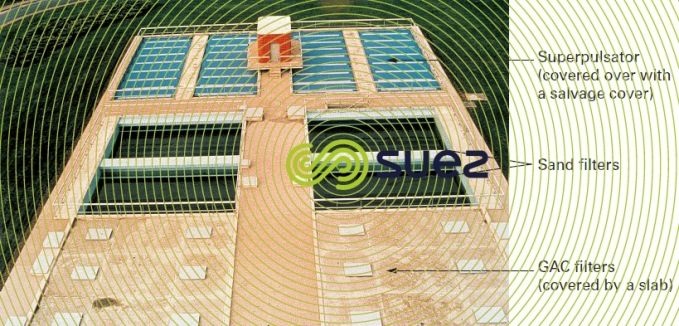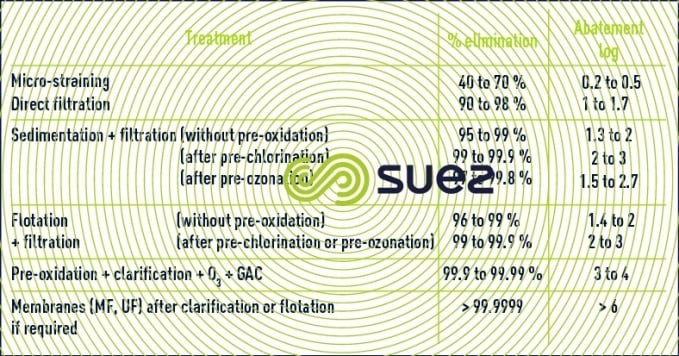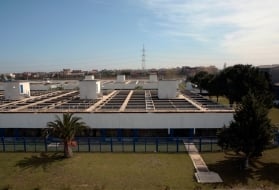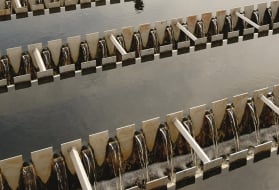problems associated with algae and zooplankton
Reading time:The following applies not only to water in a state of eutrophication where these problems tend to dominate, but also, to a greater or lesser extent, to all surface waters where, at the very least, they will be found on a seasonal basis. The following points will be reviewed (see also section (see also section importance of aquatic micro-organisms for the water treatment specialist):
- removal of phytoplankton: phytoplankton consist of micro-algae in suspension in water; these algae problems are often confused with those created by periphyton which is a mixture of micro- and macro-algae (in most cases of the filamentous kind) that develop on submerged media, especially on the walls of structures that are open to the atmosphere; when the aim is to protect clarifiers and filters from these phenomena, in the absence of pre-chlorination, these structures can be covered (e.g. opaque plastic cover) to provide effective solution (photo)
- elimination of the dissolved substances (metabolites) released by algae into their habitat;
- problems associated with zooplankton, which can be divided into two main categories:
- the risk that micro-invertebrates will penetrate into and develop in the mains networks, an aesthetic problem but one which creates many user complaints;
- the health problems posed by parasitic protozoan cysts of which Cryptosporidium are the most dangerous and the most difficult to eliminate and which, therefore, will be used to illustrate the type of treatment strategy that needs to be applied.



eliminating planktonic micro-algae
micro-straining
Using fabrics that have a mesh size typically measuring from 25 to 40 µm, the average removal efficiency will vary between 40 and 70% depending on the algae populations; individually, the smaller species (such as the Cyclotella,Stephanodiscus diatoms or the Chlorella, Scenedesmus green algae) will clearly not be eliminated nearly as thoroughly (sometimes only 10%) as multicellular species (e.g. Pediastrum), colony-forming species (e.g. Asterionella) or filamentous species (e.g. Melosira, Oscillatoria, Anabaena), where the level of reduction can reach 70 to 100%.
Additionally, this treatment has very little effect on turbidity and on the coagulant demand. Therefore, micro-straining will only apply in a few cases upstream from direct filtration (slow or fast) for removing organisms measuring significantly more than the fabric mesh; however, this does not in itself constitute a treatment, nor a cost-effective pre-treatment upstream from a complete clarification system processing water that is rich in micro-algae.
direct filtration
The use of this type of arrangement can only be considered in conjunction with coagulation-flocculation and will apply exclusively to water that has a fairly low suspended solids and algae content (see section clarification table 3). The process’s limits can be reduced considerably (< 5,000 u · m–3) with the use of multi-media filters (in practice, up to three layers) downstream from micro-strainers, or two filtrations in series. In all cases, the filtration rate selected must be adapted to the problem encountered, if possible after trials on a pilot system.
complete treatment
Water that has a high algae content must be treated using a suitable system, comprising:
- pre-oxidation: chlorine is the most effective disinfectant; however, if it cannot be used at this stage (due to concerns with THM formation…), a properly regulated pre-ozonation will also be extremely effective;
- coagulation, by adding sufficient coagulant dosage tocancel out the Zeta potential and not only for obtaining minimum turbidity levels; in order to establish the treatment rate, electrophoresis studies have to be undertaken (using the Zetameter, see specific analysis and figure 7); otherwise, an algaecount has to be undertaken on the various clarified water samples produced viajar-testing;
- clarification in a sludge blanket clarifier (Pulsator, with or without lamella), is more effective than static sedimentation; the Densadeg also produces good results; when the raw water is suitable (turbidity < 25-30 NTU), dissolved air flotation (Flotazur P or AquaDAF, see section clarification flotation units) is more advisable because it makes separation an easier task; additionally, this system will often provide more concentrated sludge (up to 25 to 30 g · L–1) and, in some cases, has made it possible to reduce the amount of coagulant used; however, if PAC is selected to resolve adhoc taste and odour problems and/or those of algae-based toxins or any other dissolved organic contamination problem, preference must be given to a sludge blanket clarifier (used alone or as part of the "extended Cristal" process, see membrane processes);
- filtration through sand or through a dual-media filter in order to the separations process.
When the plant also includes polishing using O3 + GAC, results can be improved even further; however, only the use of membranes will eliminate virtually all micro-algae. Table 8 summarises the performances that can be expected from the various technologies used under optimum conditions.



eliminating algal metabolites
Among the substances released by algae in an aquatic medium (see section micro-organisms for which freshwater is their natural habitat), the most important as far as the water specialist is concerned are sapid and odor-generating compounds as well as any algal toxins.
Conventional clarification processes generally fail to produce results with regards to both taste and odours and to toxins.
Ozone thoroughly eliminates some tastes and odours but only has a partial effect on other compounds, especially those with a molecular structure that does not have a double bond or aromatic ring (e.g. geosmine, 2-MIB); the O3 + H2O2 combination (free radical oxidation using the Perozone process) produces the best results; however, compared to ozonation on its own, this process results in increased BDOC and OM oxidation by-product (especially pesticides) formation, and has been progressively dropped accordingly.
In the absence of TOC, toxins can be eliminated using ozone, even in small doses; should this not be the case, NOM oxidation kinetics are the fastest and an appreciable O3 residual content has to be achieved (in practice, with a CT comparable to that applicable for disinfection); furthermore, not much is yet known about any toxin oxidisation by-products.
Fixing on GAC (5 to 10 vol · vol–1 · h–1) constitutes the best solution for both groups of compounds; nevertheless, saturation occurs far faster for toxins (a few months) than for tastes and odours (several years) and, in all cases, will occur faster, the more NOM there is in the water; however, as all these problems are very sporadic, especially in the case of algal toxins, the GAC can be biologically regenerated between two events, particularly with a complete polishing stage [O3 + GAC] which constitutes the choice solution (see section also polishing: removal of organic matter and micro-pollutants and Iron removal).
When there are no GAC filter cells, PAC can be used in the sludge blanket clarifier but here again, the effect of the phenomena involving competition with the NOM is very significant and the reagent demand can quickly transcend the acceptable cost-effectiveness threshold if it has to be used frequently; in such cases, it is advisable to use PAC as part of the extended Cristal process after having removed most of the OM during clarification (see section membrane processes) ; nevertheless, the choice of PAC type will be very important because the treatment rate can vary within a 1:5 ratio depending on the source of the product.
problems associated with zooplankton and protozoa cysts
protecting the mains system against micro-invertebrates
Dropping pre-chlorination has aggravated this type of problem in a number of countries. The organisms that are likely to colonise a system will be bottom-living species whose resistance or reproductive forms are brought in with the raw water, mixed in with the planktonic species: therefore, not only must all zooplankton be screened out (including the temporarily planktonic forms, eggs, cysts, larvae… bottom-living species) in the same way as for phytoplankton, but also avoid any development within the plant (particularly in the granular media filters).
A further fundamental prevention principle consists in eliminating all nutrients, whether immediate (algae, bacteria…, living or dead; organic detritus) or potential (BDOC and or NH4+) likely to encourage the regrowth of bacteria which could, in a second phase, allow microinvertebrates to develop in the distribution networks.
These possibilities lead to a number of recommendations that must not be regarded as exhaustive :
- optimised clarification, thorough removal of turbidity, TOC and phytoplankton;
- careful pre-oxidation and disinfection, even when there is no bacterial contamination (ozonation recommended);
- well designed and well run sand filtration (sufficiently frequent air + water backwashes even when fouling occurs slowly); avoiding any filter “breakthrough”;
- GAC
- clarification tanks drained out and cleaned at least once a year;
- filter backwash water treatment when this water is recycled;
- maintainance of sufficient residual chlorine levels in the treated water delivered.
Additionally, the distribution network must be properly maintained: cleaning tanks, fire hydrant flushes, interim chlorination if necessary…
eliminating parasitical protozoa cysts
As noted earlier, Cryptosporidiumoocysts will be used as an example in this illustration. In this case, chlorine and its derivatives are ineffective; oocyst elimination (expressed in log removal) in the different treatment system stages can be assessed as follows:
- Pre-chlorination: 0
- Pre-ozonization: 0 to 0.5
- Coagulation over filter: 1.5 to 3
- Clarification or flotation:1 to 2
- Sand filtration: 1 to 2
- GAC filtration: 0.5 to 1
- Ozonation (based on CT): 0.5 to 1
- UV (10 to 20 mJ · cm–2): 3
- Membranes ( MF or UF ): > 6
Overall reduction can be estimated by totalling the unit reduction values. For example, a system comprising pre-ozonation, clarification and sand filtration will provide a 2 to 4.5 log removal; in fact, 4 log removal (99.99%) is routinely achieved in well-run plants; however, use of O3 + GAC polishing will provide added security (this type of problem has strengthened the multiple barrier treatment concept).
It should be noted that membranes and UV irradiation are noticeably superior to other technologies.
In a conventional plant, recycling of the filter backwash water (see section sludge processing) constitutes a potential risk: the above values show that, in order to avoid increased oocyst levels, this type of water has to be treated with a removal potential of at least 2 logs.
Bookmark tool
Click on the bookmark tool, highlight the last read paragraph to continue your reading later














